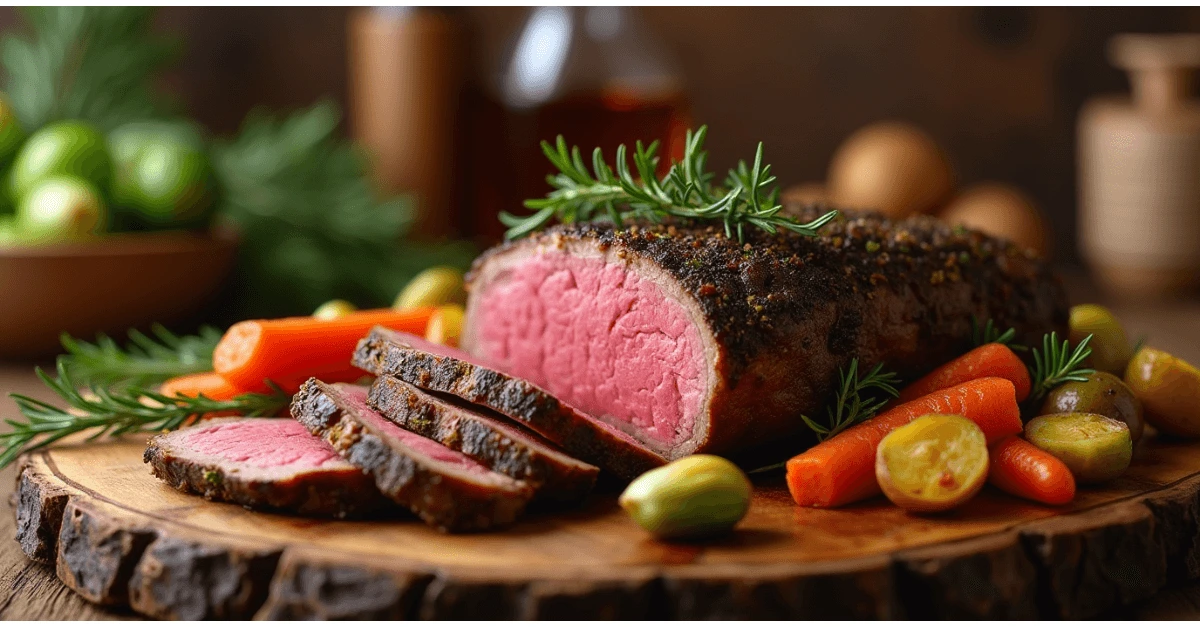Venison, with its rich, robust flavor and tender texture, is a fantastic choice for a special occasion or a hearty family meal. If you’ve ever wondered how to cook the perfect venison roast in the oven, you’re in the right place. Whether you’re a seasoned cook or a novice in the kitchen, this step-by-step guide will help you transform a simple venison roast into a dish that impresses. From preparing the roast to selecting the right sides and pairing with wines, we’ll cover everything you need to know.
Why Venison is a Great Choice for Roasting in the Oven
Venison offers much more than just a unique flavor—it’s packed with nutrients and health benefits. For those seeking lean, flavorful meat that’s perfect for roasting, venison is an excellent choice. Unlike beef, venison is naturally low in fat, making it a healthier alternative for anyone watching their calorie intake but still craving a meaty dish.
Health Benefits of Venison:
- Low in Fat: Venison is a lean meat, which means it contains less fat compared to beef or pork.
- High in Protein: It’s an excellent source of protein, which is essential for muscle repair and growth.
- Rich in Nutrients: Venison is packed with essential vitamins and minerals like iron, zinc, and vitamin B12, which are important for maintaining a healthy immune system and promoting energy levels.
Cooking venison in the oven also brings out its natural flavors, and when done correctly, it results in a perfectly tender roast that retains its moisture.
Essential Tools and Ingredients for a Perfect Venison Roast
Before diving into the cooking process, it’s important to gather the right tools and ingredients. Preparing for a venison roast is a lot like preparing for any good meal—having the right equipment and quality ingredients can make all the difference.
Tools You’ll Need:
- Roasting Pan: A heavy-duty roasting pan is crucial for even cooking and preventing juices from spilling over.
- Meat Thermometer: This tool ensures that your venison roast is cooked to perfection, preventing overcooking.
- Sharp Knife: To trim excess fat or tie the roast, a sharp knife is essential for precision.
- Foil or Roasting Lid: Covering the roast during part of the cooking process helps to lock in moisture.
Key Ingredients:
- Venison Roast: Choose a high-quality venison roast, such as a loin or shoulder, that’s fresh or properly frozen.
- Olive Oil or Butter: These fats are essential for searing the meat and adding flavor.
- Fresh Herbs: Rosemary, thyme, and sage pair wonderfully with venison and will infuse the meat with earthy, aromatic flavors.
- Garlic and Onion: These basic aromatics add depth to the flavor profile of your venison roast.
- Optional: Red wine or beef broth for basting and additional flavor.
To help organize your ingredients, here’s a table of what you’ll need:
| Ingredient | Quantity |
|---|---|
| Venison roast | 2-3 pounds |
| Olive oil | 2 tbsp |
| Fresh rosemary | 2 sprigs |
| Garlic cloves | 4 cloves |
| Red wine | 1 cup |
Having these ingredients on hand will set you up for success.

Preparing Your Venison Roast for the Oven
Before you place your venison roast in the oven, there are a few essential steps to ensure the best flavor and texture.
1. Trim the Venison Roast
Venison tends to have some excess fat, which can be trimmed away before cooking. While venison is naturally lean, removing any large chunks of fat will improve the flavor and prevent your roast from being too greasy.
2. Marinate or Season the Roast
Seasoning your venison roast is an important step that adds depth and complexity to the flavor. You can either marinate the roast for a few hours or simply apply a dry rub. A simple rub of garlic, fresh rosemary, thyme, salt, and pepper is a great option. You can also use a marinade that includes ingredients like olive oil, red wine, and balsamic vinegar for an extra layer of flavor.
3. Tie the Roast (Optional)
For an even roast, you can tie the roast with kitchen twine. This helps ensure that the roast cooks uniformly and retains its shape. While this step is optional, it can result in a more consistent texture.
4. Let the Meat Rest at Room Temperature
Before cooking, it’s helpful to let the venison roast come to room temperature. Allowing the meat to rest outside of the fridge for 30-60 minutes ensures that it cooks more evenly in the oven.
How to Roast Venison in the Oven: A Step-by-Step Guide
Now that your venison roast is prepped and ready, it’s time to roast it to perfection.
Step 1: Preheat Your Oven
Start by preheating your oven to 350°F (175°C). This is the ideal temperature for roasting venison, as it allows the roast to cook slowly and evenly while preserving its tenderness.
Step 2: Sear the Venison
Before placing your roast in the oven, sear it in a hot pan on the stovetop. Heat 2 tablespoons of olive oil or butter in a skillet over medium-high heat. Once the pan is hot, sear the roast on all sides until it develops a rich, brown crust—about 2-3 minutes per side. This step locks in the juices and helps develop a flavorful outer crust.
Step 3: Roast the Venison
After searing, transfer the roast to your preheated oven. Place it on a rack inside a roasting pan, ensuring the meat doesn’t touch the bottom of the pan. Insert a meat thermometer into the thickest part of the roast, making sure it’s not touching bone. Roast for about 20 minutes per pound of meat. Here’s a quick guide for doneness:
- Medium-rare: 130-135°F
- Medium: 140-145°F
- Well-done: 150°F+
Step 4: Rest the Roast
Once your venison reaches the desired temperature, remove it from the oven and let it rest for 10-15 minutes. This resting period allows the juices to redistribute throughout the meat, ensuring a moist, tender roast.

Common Mistakes to Avoid When Roasting Venison
Even experienced cooks can sometimes make mistakes when roasting venison. Here are some common errors and how to avoid them:
1. Overcooking the Venison
Venison is lean, which means it can dry out easily if overcooked. Use a meat thermometer to avoid this mistake and remove the roast from the oven when it’s just shy of your desired temperature.
2. Skipping the Sear
Searing the roast before roasting may seem like an extra step, but it’s essential for developing flavor. Without searing, your roast will lack the flavorful crust that makes a venison roast so delicious.
3. Not Resting the Meat
Letting the roast rest is crucial for retaining its juices. Don’t skip this step—it’ll make the difference between a dry, tough roast and one that’s juicy and tender.
How to Serve and Pair Your Venison Roast
Once your venison roast is perfectly cooked and rested, it’s time to serve it up. Venison pairs beautifully with hearty sides and rich wines.
Side Dishes to Serve with Venison
- Mashed Potatoes: The creamy texture of mashed potatoes complements the rich, gamey flavor of venison.
- Roasted Vegetables: Carrots, parsnips, and Brussels sprouts roasted with olive oil and herbs make for an ideal side.
- Cranberry Sauce: The tartness of cranberry sauce cuts through the richness of venison and adds a burst of color to your plate.
Wine Pairings for Venison
- Red Wine: Venison pairs best with bold red wines like Cabernet Sauvignon, Merlot, or Malbec, which match the intensity of the meat.
Storing Leftover Venison Roast
If you happen to have leftovers (though that’s unlikely!), storing them properly will ensure that your venison stays fresh for later enjoyment.
How to Store
- Refrigerate: After the roast cools, wrap it tightly in plastic wrap or foil and store it in the refrigerator for up to 3 days.
- Freeze: Leftover venison can be frozen for up to 3 months. Just make sure to wrap it well to prevent freezer burn.
Reheating Tips
To reheat, place the venison in an oven-safe dish and cover it with foil. Reheat at 300°F until warmed through, ensuring that the meat doesn’t dry out.
Frequently Asked Questions (FAQ)
Q1: What temperature should I roast venison in the oven?
- The ideal temperature is 350°F (175°C). Use a meat thermometer to ensure proper doneness.
Q2: How long does it take to roast venison in the oven?
- It typically takes 20 minutes per pound at 350°F, but cooking times may vary based on the size of the roast and desired doneness.
Q3: How can I make my venison roast more tender?
- Marinating the roast, searing it properly, and allowing it to rest after cooking can all help make your venison roast more tender.
Q4: Can I use other cuts of venison for roasting?
- Yes, other cuts like venison loin or shoulder can also be roasted, but you may need to adjust the cooking time based on the cut and its size.
Conclusion
Cooking a perfect venison roast in the oven is achievable with the right techniques and a little patience. By following the steps outlined in this guide, you can impress your guests with a flavorful and tender roast that’s sure to be the centerpiece of your meal. So, gather your ingredients, preheat your oven, and get ready to create a delicious, memorable venison roast. Ready to try it out? Go ahead and follow the guide, and don’t forget to share your experience with friends and family!

